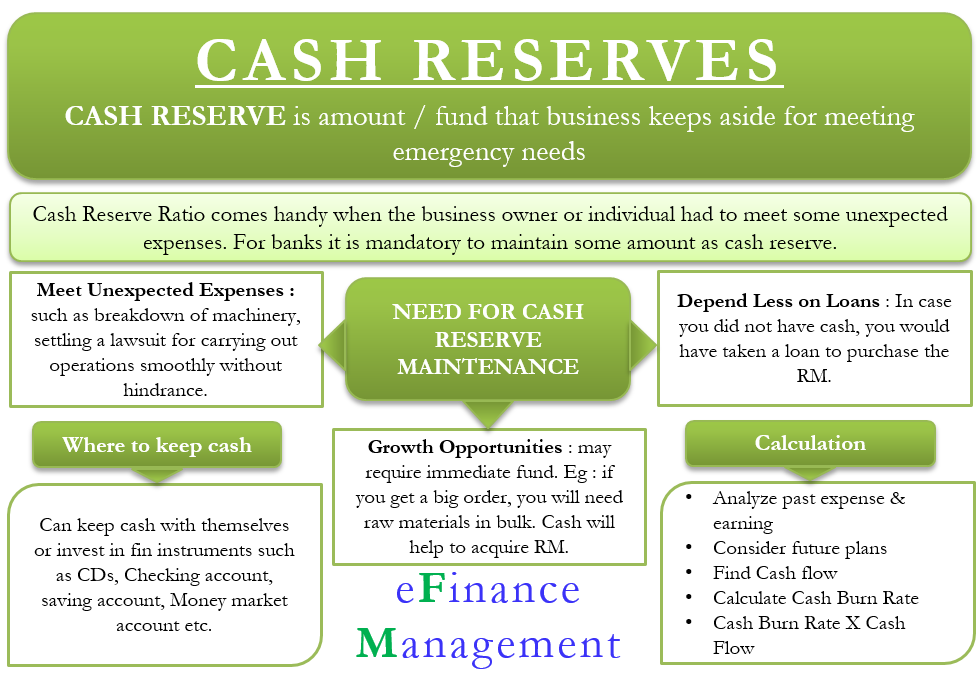Cash Reserves are the amount or funds that a business or individual keeps aside for meeting emergency needs. Basically, it is a type of saving to meet unexpected or unplanned expenses or funding requirements.
A business owner or an individual may not have access to cash all the time. And as you are aware, there are often times when the business owner or individual has to meet some unexpected expenses, such as buying new machinery, settling a lawsuit, medical emergency, or more. So, in such situations, the cash reserves come in handy.
Mostly all businesses, be it small or large, maintain some kind of cash reserves. Even the biggest names in the corporate world, such as Apple, General Electric, and Alphabet, maintain reserves between $50 to $150 billion.
Moreover, it is mandatory for banks to keep some amount of cash reserves. The amount of reserves depends on their deposit liabilities and other factors. Banks need to keep reserves either in their own vaults as cash or deposit with the country’s Central bank.
Cash Reserves – Why it’s Needed?
It helps the business to avoid a financial crunch or avoid taking loans. Businesses or individuals who don’t maintain sufficient cash reserves face the risk of bankruptcy. Apart from this, such reserves help in the following situations:
Meet Unexpected Expenses
Individuals may need quick cash if their vehicle breaks down or they forget to pay any earlier bill. For businesses, emergency situations can be a breakdown of machinery, settling a lawsuit, etc. Basically, it helps individuals and businesses to carry on with the operations as usual without worrying about unexpected expenses.
Open to Growth Opportunities
Individuals or businesses often come across opportunities to boost revenue and grow the business. However, such opportunities may require some upfront payment. For example, if you get a big order, you will need raw materials in bulk. Thus, cash in hand will help you to acquire needed raw materials.
It also helps in potential acquisitions. For instance, Google (now Alphabet) was able to acquire Nest for a price tag of $3 billion due to its reserve.
Depend Less on Loans
Picking up the same example as above, if you get a big order for which you need more raw material and if you don’t have a cash reserve, you may have to take a loan to get the needed raw material. Taking a loan not only puts pressure on your financials but also squeezes your profit margin as you have to pay interest expenses as well.

Where to Keep Cash Reserves?
Businesses either keep the cash reserves with themselves or invest it in a financial instrument, where they can quickly access it. Such short-term, highly liquid investment earns a low-interest income but is almost risk-free. This is understandable as the primary objective of this saving is not to earn interest but rather quick access in times of need.
Also, the businesses or companies must invest in instruments that allow them to exit anytime without any charges, irrespective of how the markets perform. Such instruments are checking accounts, savings accounts, money market accounts, money market funds, certificates of deposit (CDs), and even short-term Treasury Bills.
How Much Cash Reserve is Enough?
Normally, businesses or individuals should keep reserves enough to meet their expenses for at least three to six months. However, there is no one-size-fits-all amount of a cash reserve. An individual or company must assess their financial needs to determine the amount they must keep as a cash reserve.
How to Calculate it?
A simple way to do this is to analyze the past expenses and earnings of your business. Also, one must factor in the future plans (if any). Reviewing the cash flow statement also helps with the reserves.
Calculating the cash burn rate is an effective way to determine the cash reserves. The cash burn rate is the amount of money that a business loses due to expenses. It can be calculated using the cash flow statement. One needs to subtract the revenue from the money spent to arrive at the net burn rate.
Next, multiply the net burn rate by the number of months you want to maintain the reserves for. For example, if you want to know the reserve amount for three months, then multiply the burn rate by three.
One can also use the budget and projected cash flow to arrive at the cash reserves. Such a method, however, suits the startups that don’t have past financial statements to refer to.
Additionally, some businesses maintain the reserves only for fixed overhead costs, such as rent, utilities, and insurance. These are the expenses that a business has to pay even, irrespective of the sales.
RELATED POSTS
- Official Reserve Account – Meaning, Importance, and More
- Working Capital Management
- Importance of Working Capital Management
- How to Improve Liquidity by Effective Cash Management?
- Advantages and Disadvantages of Working Capital Management
- Revaluation Reserve – Meaning, Accounting, Journal Entries, and Example

